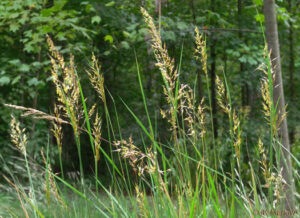by CMG Betty J
The Texas Hill Country is a defined area of nineteen counties situated within the Edwards Plateau. Since the region takes up about 24 million acres, the diversity of its flora and fauna reflects that vast size. Some 280 species of grasses are found here. Some are native and some have been introduced, either intentionally or not. Texas Parks and Wildlife lists the five most common grasses for the Edwards Plateau as silver bluestem, Canada wildrye, big muhly, little bluestem and Indian grass.
Native grasses provide food for wildlife and some grazing for cattle. The deep grass roots protect slopes from erosion and keep the soil from compacting so water can seep into the aquifer below.

Indian Grass
Indian grass, also known as yellow Indian grass, sorghastrum nutans, is a tall perennial native bunchgrass with long, wide leaf blades. The 30-36 inch seed stalks are topped with golden spikes. This grass occurs both in bunches and as a single stem among other grasses. It is a prolific seed producer and provides a good source of seeds for small mammals and birds. In nature it is very drought and cold tolerant, but in the landscape, it prospers best in a moist area. The bloom begins in mid-spring and seeds are produced from September until December.